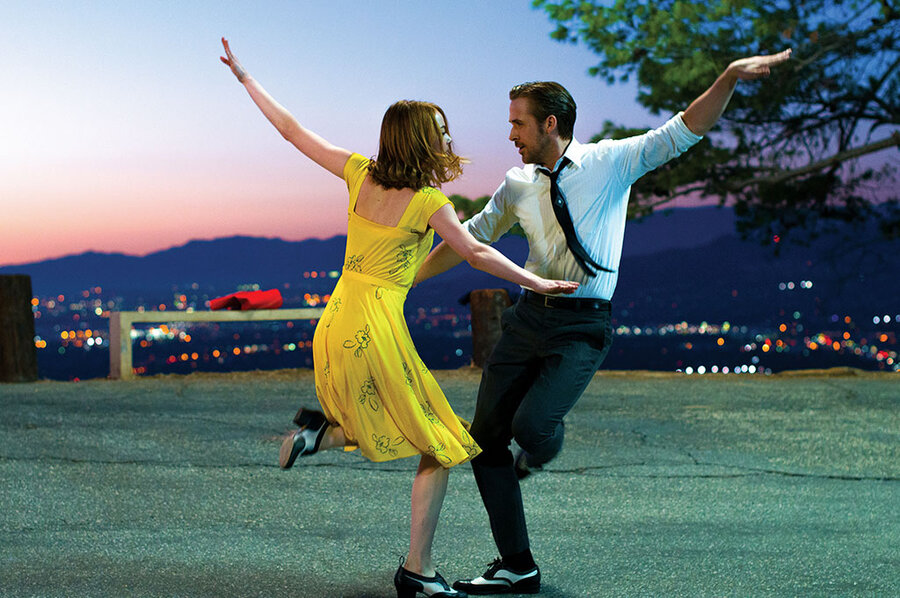'La La Land' is a deliriously fine musical about the challenges of making art
Loading...
The deliriously fine movie musical “La La Land” opens with a bravura set piece, shot in a single extended take, of a massive jam on a Los Angeles freeway. Stuck and going nowhere, the passengers exit their cars and shimmy and scamper through the stalled traffic in joyous exultation as they belt out the words to the song “Another Day of Sun.”
You have to be pretty ecstatic to jump for joy amid L.A.’s soul-sucking freeway pileups. It’s a tribute to writer-director Damien Chazelle, and songwriter Justin Hurwitz (with lyrics by Benj Pasek and Justin Paul), that all this supernal silliness is tinged with not the slightest cynicism. The sun-worshipers who pour out of their cars are celebrating the simple, sensual thrill of being alive.
The movie needs this opening elation because so much of what follows is about the bittersweet disappointments of dreams deferred. La-La Land is the place where people’s pipe dreams portend a rude awakening.
The lovers in “La La Land” are Mia (Emma Stone), who works as a barista on the Warner Bros. lot and is always racing to movie auditions that never pan out, and Sebastian (Ryan Gosling), a jazz pianist who dreams of opening his own club but in the meantime is stuck playing cheesy standards in bar lounges or synthesizers for tacky 1980s cover bands. Mia and Sebastian have already met cute in that traffic snarl. It’s hate at first sight, which, of course, means they will ultimately become entranced.
Mia doesn’t even like jazz, though she pretends to. It’s Sebastian’s passion for jazz that she responds to; she wants to rouse him out of his funk so he can fulfill his dreams. She has no such faith in herself. For her, acting is a rapidly approaching dead end. But he sees in her a purity that cuts through all the corruptions of showbiz. Gently dancing together at night on a hillside with the city spread out before them and the sky as brightly multihued as in any classic MGM musical, they represent, as so many iconic musical characters do, the ardency of being in love.
Filming in glorious anamorphic CinemaScope and 35mm, Chazelle is offering up a tribute to the great Hollywood musicals of the ’40s and ’50s, and also, unmistakably, Jacques Demy’s great 1964 film “The Umbrellas of Cherbourg,” which was itself an homage to those earlier movies. Like Demy, Chazelle recognizes that there was a great deal more realism and rue in those films than is popularly recognized. (The range of emotions in “Meet Me in St. Louis” is as great as in any dramatic film from that era.) He understands that it is possible to make piercingly personal movies within highly stylized, “artificial” settings. This is why, when Mia and Sebastian break into song and dance in “La La Land,” there is nothing laughable or antiquated in the attempt. It just seems like the most natural thing in the world for them to do – a poetic emanation of their closeness.
The fact that neither Stone nor Gosling are tip-top song-and-dance artists is, in some ways, integral to their appeal. If they were Ginger Rogers and Fred Astaire, we might not feel as much of a kinship with them. Stone, in particular, has the kind of fresh, pert looks that would have fit right into Hollywood’s golden era, but there’s a trace of sadness in her eyes that complicates the iconography. The same goes for Gosling, who cuts a glamorous figure even when he’s slumming and yet, as Sebastian, often seems formidably closed off from happiness. (He loves bluesy jazz because, we sense, it lyricizes his funk.) These lovers are connected as much by their sense of loss as by their aspirations.
“La La Land” is about the difficulty in reconciling one’s artistic ambitions – one’s hopes – with the hard realities of the world. This was also the theme of Chazelle’s previous movie “Whiplash,” except in that film, temperamentally so opposite from “La La Land,” he lost sight of what he was doing and the movie turned into a paean to a tough-love sadist of a music teacher. In “La La Land,” Chazelle never for a moment loses the thread. The entire film seems to have been conceived in a state of controlled bliss. Even at its saddest, there’s a vitality, a sense that what is happening to these people is of the utmost import because their dreams are also so much our own. The movie ends with a what-might-have-been fantasia that is one of the most emotionally moving passages I’ve ever seen in a musical. It’s like a bluesy jazz piano chord, full of hurt and healing, that slowly fades to silence. Grade: A (Rated PG-13 for some language.)






